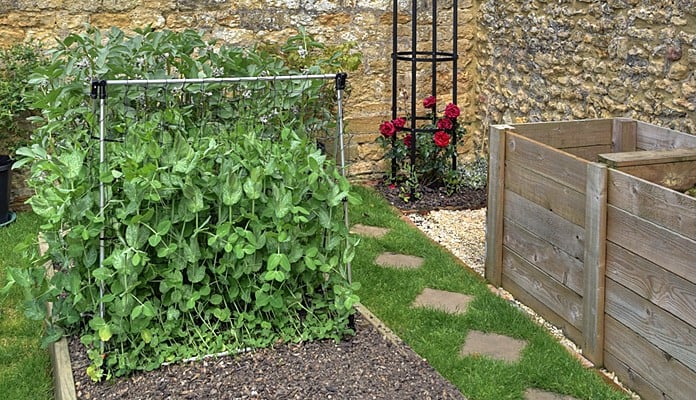For gardeners growing vining crops like pole beans cucumbers tomatoes, and peas, providing sturdy support structures is essential. Rather than letting vines sprawl on the ground, climbing frames keep plants upright for better health, productivity, and ease of care and harvest.
Metal and wood garden frames tailored for climbing plants offer the strength needed to support heavy crop loads. They transform messy, tangled vines into beautiful vertical displays. Here’s an overview of different types of climbing plant supports and how to incorporate them in your landscape.
Popular Options for Vining Crops
Trellises
Free-standing or wall-mounted lattice panels keep vines organized and lifted off the ground. Ideal for cucumbers, beans, peas, and tomatoes.
Obelisks
Tall, slender towers allow vines to be trained around a central pole Perfect for pole beans and ornamental climbers.
Arbors
Walk-through structures covered in foliage create shaded entryways. Grapevines and flowering vines like clematis thrive on arbors.
Pergolas
Crisscrossing overhead beams offer attachment points for vines. Inviting covered spaces result when combined with vining plants.
Fences
Short trellis fence sections keep plantings tidy and contained Bush beans and peas grow well supported on fences,
Cages
Enclosures support plants from all sides, keeping fruit up off the soil. Tomato cages are the most common example.
Key Benefits of Using Climbing Frames
Taking advantage of vertical space optimizes small garden plots. But besides saving space, climbing frames offer additional benefits:
- Increased light exposure and air circulation
- Reduced disease and rot by lifting fruit and foliage
- Easy tending and picking without stooping or kneeling
- Higher yields with more organized growth
- Neater appearance versus sprawling vines
- Extended harvest period into fall before frost
- Versatile and movable to use year after year
Tips for Setting Up Climbing Supports
When installing climbing frames in your vegetable garden:
- Place structures in spring before planting vines
- Position to avoid shading other plants as vines grow
- Align end posts solidly and anchor well into ground
- Set up parallel to rows with 3-4 feet between frames
- Make sections at least 6 feet wide for easier access
- Install trellises 6-8 feet tall, obelisks up to 10 feet
- Angle top slightly toward sunlight to train growth upwards
- Use biodegradable plant ties to loosely attach vines
- Prune vines once they reach the top to promote branching
Get Creative with Structures
Don’t limit climbing frames to straight rows in a vegetable plot. Also utilize them:
- Along a porch, patio, or deck for screening
- Over pathways and garden entries for flower ceilings
- Flanking gateways, doors, and garage doors
- Against sunny house walls in lieu of espalier trees
- Around rain barrels, compost bins, or sheds to obscure
- As movedable dividers between raised beds
- For vertical flower walls with blooming vines
With creativity, the possibilities are endless for putting climbing plants and structures to work enhancing your garden. The vertical dimension opens up new realms for growers with limited space.
Discover the joy of nurturing vining crops up garden frames and trellises. Abundant harvests and beautiful displays will soon surround you!
Frequently Asked Questions
What are the best frames for climbing vegetables?
Trellises, cages, obelisks, pergolas, arbors, and fences are great for supporting vining vegetable crops like tomatoes, pole beans, peas, cucumbers, and squash.
How tall should climbing frames be?
Aim for 6-8 feet tall for most vegetable vines. Some can grow 10 feet or taller, so size appropriately for the plant variety.
Where should I position climbing frames in my garden?
Place structures parallel to garden beds before planting. Ensure at least 3-4 feet between rows to allow access.
How do I attach vines to climbing frames?
Use soft, biodegradable plant ties to loosely secure vines to supports as they grow. Avoid sharp wire or tight bindings that will cut into stems.
What are some creative ways to use climbing frames?
Along walkways, around raised beds, flanking doorways, obscuring compost bins, and anywhere vertical space allows you to get creative!
Take your garden to whole new heights!
Covered in Morning Glories, this obelisk provides beautiful vertical interest in the landscape.
If you visit British flower gardens for a week or two, you’ll have a whole new understanding of how climbing plants can make a garden look better. Each wall is covered with roses and climbing hydrangeas, and clematis grows through the trees and shrubs. Honeysuckle and ivies cover the arches and fences, and sweet peas, morning glories, and thunbergia cover the obelisks. Passionflower vines, jasmine, mandevillea, and bougainvillea fill pots and planters of all shapes and sizes.
Free shipping on orders over $149 – Enter code DAHLIA24 at checkout
This Free Shipping offer expires 6/30/24 and requires a $149 minimum purchase amount. This offer cannot be applied to previous purchases or combined with any other offer. This deal only works for Economy Shipping within the lower 48 states. It can’t be used for items that require faster shipping, items that cost more to ship, or delivery services from our garden centers.
Find more garden information
5 Best Bean Poles, Frames and Supports for Your Garden
- The Ultimate Guide to Growing Strawberries in Raised Beds - August 8, 2025
- No-Dig Garden Beds: The Easiest Way to Grow a Beautiful Garden - August 6, 2025
- How to Protect and Preserve Wood for Raised Garden Beds - August 6, 2025

